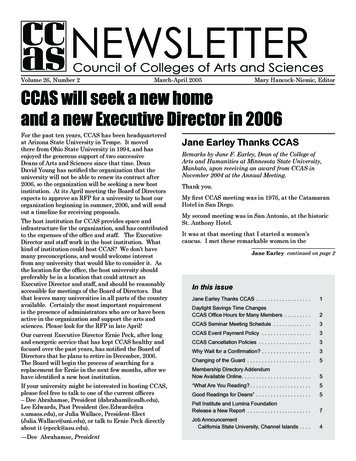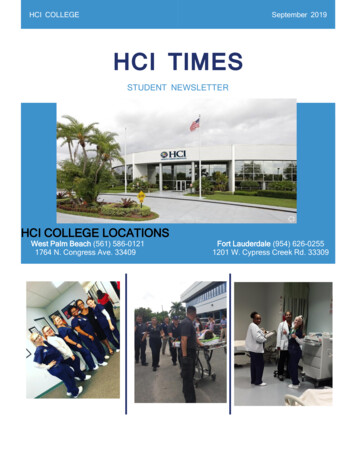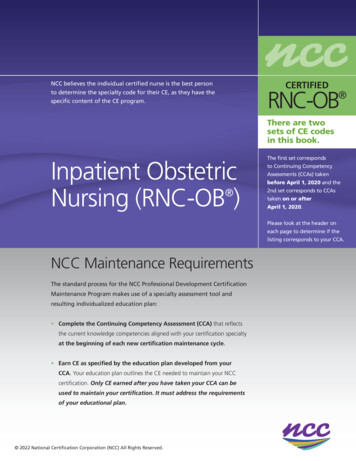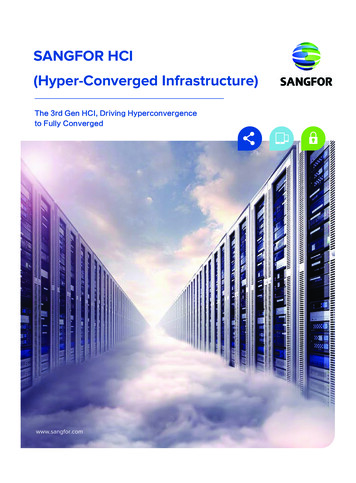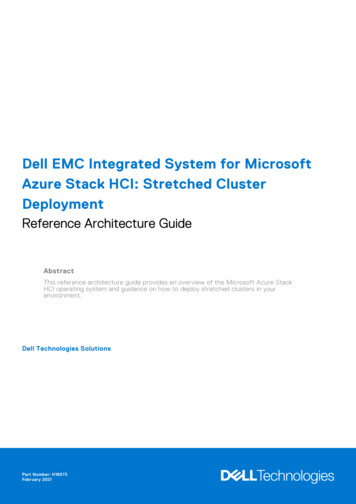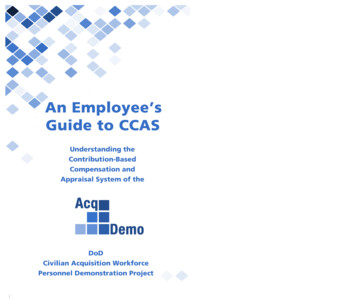
Transcription
An Employee’sGuide to CCASUnderstanding theContribution-BasedCompensation andAppraisal System of theAcqDemoDoDCivilian Acquisition WorkforcePersonnel Demonstration Project
5Supervisor’s AnnualAppraisalOrganization MissionEmployee Self-AssessmentGuidance from PersonnelPolicy Board andPay Pool ManagerCustomer InputOCSPay Adjustment/AwardQuality of Performance AppraisalPreliminaryFactor RatingsOrganization d Changes toContribution PlanRecommended Changesto IDPTrainingOrganization MissionKey PlayersPosition InformationExpected ContributionExpected OCS & MID-POINTREVIEWOrganization MissionSelf-AssessmentSupervisor InputCustomer InputContributionto Mission3EMPLOYEESELFASSESSMENTSupervisor’s AnnualAppraisalCIP (if required)OCSPay Adjustment/AwardData on sSupervisor FeedbackRevised Contribution PlanRevised IDPRequired Follow-upCIP (if required)
ContentHow to Use This Guide3Getting Started51Contribution Planning92Mid-Point Review113Employee Self-Assessment134Supervisor's Annual Appraisal175The Pay Pool Panel Process216Quality of Performance257Communicating CCAS Results278CAS2Net31Glossary33Factors371
2An Employee’s Guide to CCAS
How to Use This GuideWelcome to the DoD Civilian Acquisition Workforce PersonnelDemonstration Project–AcqDemo. AcqDemo was implemented in January1999 to experiment with new and different personnel managementconcepts and determine whether such changes in personnel policy andprocedures would result in improved Federal personnel management.AcqDemo is a flexible and responsive personnel system designed toenhance the DoD’s ability to attract, motivate, and retain a high-qualityacquisition workforce.This employee guide was developed to help employees entering theprogram succeed in AcqDemo. It describes the steps you should take toensure the program works for you.This guide is not designed to cover every detail of the program. Visit theAcqDemo website at http://acqdemo.hci.mil to check out a wealth ofadditional resources such as Federal Register Notices and other policydocuments, Operating Procedures, training opportunities, appraisal results,and contacts for additional information about AcqDemo.The employee guide is structured around the annual cycle of AcqDemo’sperformance management system – the Contribution-Based Compensationand Appraisal System, commonly referred to as CCAS. CCAS is designed tomeasure and reward an employee’s contribution to the mission and goals ofthe organization. It will be the central focus of your AcqDemo experience.Key “events” in the annual CCAS cycle and the actions needed to prepare foreach event are highlighted in this guide as well as what you should expect togain from each one. The CCAS appraisal cycle officially begins on 1 Octoberand ends on 30 September of the following year. It also extends beyondthis appraisal period to include the three months immediately following 30September for the pay pool panel review process. Refer to the chart insidethe front cover of this publication for a summary of the key events in theCCAS cycle AcqDemo follows.3
4An Employee’s Guide to CCAS
Position InformationGetting StartedTrainingThe key to the success of AcqDemo is the training provided for all involved.The AcqDemo Project Office has provided a full course curriculum toaddress all aspects of the AcqDemo program.Position InformationWhen transitioning into AcqDemo, you need to understand how yourposition of record will be defined. First, depending on your occupationalseries, your position will be included in one of three separate and distinctcareer paths:NH – Business Management and Technical Management Professional;NJ – Technical Management Support; orNK – Administrative SupportA crosswalk between occupational series and AcqDemo career paths can befound in the AcqDemo Operating Guide, Chapter 3.Next, you will be assigned to one of the broadband levels in your careerpath which replace the General Schedule (GS) grades. The GS grades wereused to establish the upper and lower dollar limits of the broadband levels.The AcqDemo broadband level descriptors are applied to the duties andresponsibilities of your position and the qualifications required to performthose duties and responsibilities. This results in a broadband leveldetermination.5
The AcqDemo’s career paths and broadband levels.BroadbandNH-Businessand tiveMgmt. SupportSupportIGS 1-4GS 1-4GS 1-4IIGS 5-11GS 5-8GS 5-7IIIGS 12-13GS 9-11GS 8-10IVGS 14-15GS 12-13Upon transition into AcqDemo, your position description (PD) will bereplaced by a Position Requirements Document (PRD). The PRD combinesposition information, staffing requirements, and factors into a singledocument. It includes a description of job-specific information you arealready familiar with (position title and occupational series) in addition toinformation specific to AcqDemo (career path, broadband level, factors anddescriptors).The broadband factors and descriptors are used to classify positions at theappropriate broadband level and to measure an employee’s contribution tothe mission of the organization. Taken together, these factors anddescriptors capture the critical content of jobs in each career path. Thethree factors are:1.2.3.Job Achievement and/or InnovationCommunication and/or TeamworkMission SupportEach factor contains descriptors and discriminators for each respective levelwithin the relevant career path. Complete sets of factors, descriptors, anddiscriminators for each career path are included at the end of this guide.Organization InformationOnce you are assigned to a position, you will need to know how yourposition fits into the organization. First, since AcqDemo is structured torecognize your contribution to the mission, it is essential you know andunderstand the organization’s mission. There should be no doubt in yourmind about the relationship between your position, specified duties, and6An Employee’s Guide to CCAS
the organizational mission; so, it is important you make sure your goals andobjectives are linked to the organization’s mission.Under AcqDemo, you are a member of a pay pool. A pay pool is a group ofemployees who are evaluated together under AcqDemo’s performancemanagement system, the Contribution-Based Compensation and AppraisalSystem, or CCAS. Pay pools are usually based on organizational structureand typically include employees of many functional areas (such ascontracting personnel, engineers, and budget analysts). For example, allemployees in a division or a directorate would probably be in the same paypool. A pay pool should consist of between 35 and 300 employees.The pay pool manager is the individual within the pay pool who isresponsible for managing the CCAS process. As such, the pay pool managerhas annual pay adjustment authority though determinations made by thepay pool manager are subject to higher management review. Pay poolmanagers are designated by the local participating organization orequivalent.The pay pool panel, which includes the pay pool manager and rating officialswho normally report directly to the pay pool manager, determinesemployees’ final Overall Contribution Score (OCS), pay adjustments, andcontribution awards.Responsible for overseeing the civilian pay budget, determining theorganization’s pay pool structure, providing guidance to pay pool managers,and overseeing the overall operation of the CCAS process is the PersonnelPolicy Board, or PPB. The Personnel Policy Board is a group of senior levelmanagers representing each organizational unit.CAS2NetYou will use CAS2Net to document contribution planning, and any necessaryassessment and/or feedback between you and your supervisor. CAS2Net isshort for the Contribution-Based Compensation and Appraisal SystemSoftware for the Internet.It is a DoD-sponsored web-based software application which is maintainedby the DoD AcqDemo Program Office. A guide on CAS2Net operations isavailable on the AcqDemo website and includes details on how to accessCAS2Net and navigate through the modules.7
8An Employee’s Guide to CCAS
IDPContribution1Expected1Contribution PlanningCCAS, AcqDemo’s performance management system, is designed to equatean employee’s compensation to his/her level of contribution to the missionof the organization. You and your supervisor will plan how you willcontribute to the mission during the appraisal year at the beginning of theCCAS cycle. Contribution planning, as well as any needed adjustments, aredocumented in CAS2Net.The contribution planning discussion with your supervisor at the beginningof the appraisal cycle should cover the following topics: Career path and broadband levelFactorsExpected Overall Contribution Score (EOCS) and RangeOrganizational missionExpected levels of contribution and expected resultsPerformance Appraisal Quality Level (PAQL/Quality of Performance)Career development (Individual Development Plan, or IDP)Be sure to use this exchange with your supervisor for the mentoringopportunity it presents. Discuss areas where you’d like to grow or expandyour responsibilities and solicit your supervisor’s feedback on ways toaccomplish your goals.As you consider how you plan to contribute, you must also discuss theintended results. Is there a specific target you are trying to reach?9
Try to identify milestones or other measurable evidence of success. Don’thesitate to ask questions about anything you don’t understand. This is youropportunity to create a clear plan for the coming year.Since all employees are rated on all three factors, it is advisable to considerhow your plan relates to contributions for each factor. Plans should includegoals or objectives that are: Concise and Contain detailed, specific information on how the activity will benefitthe organizationIn other words, the plan should pass the “so what” test, should be succinct,and should clearly describe expected results.ExampleFirst Draft: Conduct an analysis of contaminated water samplesfor the Army Corps of Engineers.- This does not pass the “so what” test. It states a task, but not theexpected outcome or why it is beneficial for the organization.2ND Try: Conduct a monthly analysis of contaminated watersamples for the Army Corps of Engineers in order to providetime-critical environmental contamination information.- This provides both the benefit for the organization and detailson when it will be accomplished.At the conclusion of the contribution planning step, you should have a clearunderstanding of what you need to do to effectively contribute to yourorganization’s mission and how your EOCS and Range is linked to your basicpay. You should also understand how the factors, descriptors, anddiscriminators will be used to measure your contributions and whatrequirements for education, training, and experience are necessary toenhance your ability to contribute (i.e., elements of your IDP).Frequent communication with your supervisor is encouraged throughoutthe CCAS cycle to discuss how your work is progressing and whereadjustments need to be made. Never hesitate to ask your supervisor forfeedback.10An Employee’s Guide to CCAS
22Mid-Point ReviewFrequent formal and informal feedback during the appraisal cycle is key toAcqDemo’s emphasis on increased communication between supervisors andemployees. Without feedback, you have no checkpoints to gauge if you areon the right path. At best, you may accidentally reach your goal. At worst,you will wander aimlessly, never reaching your destination. People need toknow how they’re doing, what’s working, and what’s not.At the mid-point of the CCAS cycle, you will have a formal Mid-Point Reviewwith your supervisor. This review provides you with important feedbackregarding your progress. To start the review process, your supervisor willask you to complete a Mid-Point Self-Assessment in CAS2Net. Yoursupervisor will then use the supervisory CAS2Net module to enter anarrative detailing your progress to date. Next is a discussion between youand your supervisor. A few things to consider as you prepare for themeeting with your supervisor: Your supervisor should prepare an agenda in advance to ensure majorissues are not overlooked. You may wish to provide your supervisorwith a list of concerns prior to your meeting so you are both prepared11
to discuss your contributions and have any relevant documentation tosupport your activities on hand. Write out your questions so they arenot overlooked during the course of the meeting. During the mid-point review, you and your supervisor will measure theprogress you’ve made toward the expectations set at the beginning ofthe CCAS cycle, discuss your strengths and weaknesses in areas ofcontribution to the organizational mission, and make adjustments asnecessary. Specific work assignments may change at any time based onmission requirements. Your supervisor will document the discussion in CAS2Net and his/herrelated narratives should focus on agreed-upon milestones and followup activities. You should get feedback on each one of the three factors. Yoursupervisor should talk to you about opportunities for improvement,such as training options and adjustments to your IndividualDevelopment Plan (IDP) if you’ve identified gaps in skills. If you learn that your contributions are not meeting expectations, youneed to find out:-What improvement is required?-How will improvement be recognized?-What assistance is required?-Are there consequences for not improving?Your supervisor should identify any deficiencies and highlight ways you canimprove your contribution. If it is determined you are not effectivelycontributing to the mission, you may need a Contribution ImprovementPlan, or CIP. The CIP is a formal process to correct deficiencies byidentifying specific areas where your contribution is inadequate,emphasizing standards for adequate contribution, and outlining actionsrequired of you. It will also identify resources available to assist you. TheCIP can become the starting point to help you get back on track. For moredetails on the CIP, see Chapter 7, Communicating CCAS Results, in thisGuide.There should be no doubt in your mind where you stand after feedbacksessions with your supervisor, and there should be no surprises when itcomes time to review your CCAS results at the end of the CCAS cycle.Mid-point feedback and any additional formal feedback you receive duringthe appraisal cycle is documented in CAS2Net.12An Employee’s Guide to CCAS
3Mission3Employee Self-AssessmentAt the end of the appraisal cycle, your supervisor will ask you to complete aself-assessment describing your contributions to the mission of theorganization.Your supervisor should provide guidance on applicable local policies forsubmitting your self-assessment, such as writing style (bullets or narratives),amount of detail required, and a due date. You should consider setting aself-imposed completion schedule that complements your supervisor’sstated guidelines. Build plenty of time into your schedule to review yourfinal product. You may want to have your supervisor review yourassessment prior to the due date. Time management is critical forcompleting the writing tasks related to your assessment.As you prepare your self-assessment, you will need to have a copy of yourorganization’s mission statement and a copy of your PRD which contains thethree factors and level descriptors for your broadband level and careerpath. These will be used to measure your contribution. Your supervisor andthe pay pool panel will rate your level of contribution to the mission foreach of the three factors. Each factor is considered critical to the success ofyour organization’s mission. A review of the factor descriptors anddiscriminators in the PRD will give you an idea of the types of contributionsconsidered typical for a position operating at the top of your broadbandlevel. You can review factor level descriptors for all career paths andbroadband levels at the end of this guide.To write an effective assessment, you need to ask yourself, “So what?” foreach accomplishment. Identify the impact your contribution had on13
achieving an organizational goal. Concentrate on substance and content asopposed to length. Focusing on the link between your contribution and thebenefit to the mission will serve you better in pay pool reviews than lengthydescriptions of your efforts.The annual appraisal is not a laundry list of skills you possess nor is it anassessment of potential. Rather, it is a set of statements that reflect whatyou did and how those contributions helped further the mission of theorganization. When supervisors are assessing employees under CCAS, theythink not only “WHAT” (the activity) and “HOW” (the level of performance)but also “WHY” (the benefit that contributed to meeting the mission). Bespecific when writing your self-assessment. Do not leave it to others topresume contribution.It is also important to remember that a singular work activity may result incontributions that apply to more than one factor.ExampleFirst Draft: “I published three technical journal articles duringthis appraisal period.”- This implies a contribution but does not state one. Whatimpact did the publishing of those articles have? Did theycapture the objectives of the team or organization? Even if theactivity accurately implies contribution, a lack of amplificationand detail can make the statement ineffective.2ND Try: “This year I published three technical journalarticles on technical subject which resulted in a desiredadvancement in the technology in direct support of ourmission to specify goal by specific impact .”- Remember, always think in terms of cause and effect, or “SoWhat?” when writing contribution statements: “The employeedid A that resulted in B which is related to the mission .”Effective Self-Assessment Examples Developed a computer program to track material storage and delivery ofweapon system parts from the Supply Department to the OperatingForces. This tracking system cut reorder costs by 20% and improveddelivery time on average by 20 days.14An Employee’s Guide to CCAS
Coordinated with a number of organization elements and contractors toresolve a classified e-mail problem that resulted in the enhancement ofoperational security for all parties involved. This solution was adoptedDoD-wide. As the Help Desk Assistant, assisted over 300 Operating Forces customersmonthly by providing accurate and timely responses to all questions andrequests for assistance. This has resulted in improved relations betweenthe help desk and the Operating Forces, favorable commendations to theCommand, and improved communications between our projects and theOperating Forces. Volunteered to take the lead in teaching six Microsoft Office classes andvarious administrative correspondence courses to other OfficeAutomation Assistants and division personnel. This saved approximately 15K in TAD and vendor training costs, which was then allocated to otherpriority projects. Established contact with matrix activities, HQ, and other services andagencies to provide/maintain accurate information on the XYZ program. This resulted in improved interoperability and assureduniform understanding of the mission. Provided improved budget procedures and guidance. Oversaw year-endcloseout with all accounts meeting or exceeding HQ execution goals forthe fiscal year. The improved procedures saved 72K in funding due totimely reallocation of funding and resolution of errors.Your descriptions of your contributions must be documented in the AnnualAppraisal Self-Assessment module in CAS2Net.15
16An Employee’s Guide to CCAS
44Supervisor’s Annual AppraisalAt the end of the appraisal period, your supervisor will assess the level ofyour contribution for each factor and determine your preliminary factorscores. In preparing your appraisal, your supervisor may consider inputsfrom a variety of sources to best capture the impact of your contributions tothe organization's mission. During this time, the initial source manysupervisors consider is personal observation and knowledge of yourcontributions. If you and your supervisor jointly planned how you wouldcontribute to the mission at the beginning of the appraisal period andmonitored your progress throughout, then your supervisor should have anexcellent frame of reference for the assessment.However, as previously mentioned, never count on the supervisor’sknowledge and observations alone to best capture your contributions. Eventhe most effective supervisor could use a reminder of your contributionsthroughout the appraisal period.Remember, YOU are the best source of inputs that your supervisor shouldconsider in preparing YOUR assessment. Only you are the expert at what17
you do, so be sure to capture that information in CAS2Net for yoursupervisor’s consideration.In addition to your input, and your supervisor’s personal knowledge of yourcontributions, there are other various sources of input that may beconsidered by your supervisor. These sources are generally referred to ascustomers because they have received some service or product provided byyou during the cycle. Customers may include other supervisors and teamsthat you have worked with on projects, counterparts in a relatedorganization, or personnel at the end of a product chain you support.Using these inputs, your supervisor will assess your contribution to themission. Each factor will receive two types of scores, a categorical score anda numerical score. The chart on the next page shows the broadband levels,categorical scores, and their associated numerical score ranges availablebased on an employee’s career path. With the exception of the Very Highcategorical scores and associated numerical scores, the entire range ofcategorical and numerical scores are available for an employee’sassessment in the listed career path regardless of assigned broadband level.The Very High factor score may only be assigned to employees at thehighest broadband level of their career path.It is important to note that the categorical designations are not adjectival tothe quality of the contribution—they define groupings of point rangesassociated with each category. For example, an NH-III employee who has asalary at the beginning of the broadband level and receives a factor score of3 Low is considered to be contributing at an acceptable level. An NH-IIIemployee who is earning a salary at the top of the broadband may havecause for concern if he or she receives a 3 Low categorical score since higherpay levels carry higher contribution expectations.The process for scoring a factor begins by assessing the appropriatebroadband level. A preliminary categorical score is assigned first; employeecontributions to organizational mission are further distinguished by theselection of a preliminary numerical score within the assigned categoricalrange.18An Employee’s Guide to CCAS
LevelsNH PointRangeNJ PointRangeNK -46Medium High51-6141-46--Medium41-5036-4030-41Medium alHighVery HighMediumScoreLowHighIVIIIIIISupervisors normally prepare the Annual Appraisal by mid-October, so it isready for review by the pay pool panel by mid- to end-October. Check withlocal policy for submission dates. The pay pool panel uses the employee’sAnnual Appraisal Self-Assessment and the Supervisor’s Annual Appraisal asthe primary sources of information about the employee’s contribution.The Supervisor’s Annual Appraisal is also used in the feedback session heldbetween you and your supervisor at the conclusion of the CCAS cycle.Because of the qualitative information it provides regarding yourcontributions within each factor, this form is the best source of the detailsthat led to your Overall Contribution Score (OCS).19
20An Employee’s Guide to CCAS
OCSPay Adjustment/AwardQuality of PerformanceRatingOrganization MissionPolicy Board and5The Pay Pool Panel ProcessThe AcqDemo pay pool panel process is designed to validate assessments ofcontribution against the three factors among a group of peer managersfrom across the organization. The result: fairness and standard applicationof the factor descriptors. Let’s explore the actions that are taken to preparefor a pay pool review and what happens during a pay pool panel meeting.Actions Taken Before the Pay Pool Panel ProcessAt the onset of each appraisal period, Personnel Policy Boards convene toestablish the pay pool structure for the organization, validate pay poolbusiness rules, and administer funds to pay pool managers.Actions Taken by the Pay Pool PanelThe pay pool panel is normally composed of the pay pool manager andthose who report directly to him/her. Their purpose is to share a commonunderstanding of the organization mission, goals, and objectives whenreviewing the assessments of subordinate supervisors and bring a commonperspective to how employees are evaluated and, therefore, compensated.21
Employees are assessed based on the same three factors addressed in thePRD within a high, medium, or low range of categorical scores. The factordescriptors are written to reflect the highest level of contributionexpectations for each broadband level. This provides perspective for arating supervisor. If the individual is contributing solidly against all of themajor points in the descriptor provided, then a higher category of ratingwould be appropriate. On the other hand, someone who is only contributingagainst some of the descriptor requirements or all requirements but to alimited degree would earn a lower categorical rating. A numerical score isdetermined for each factor, and the total is divided by three, then roundedto the nearest whole number, to produce an Overall Contribution Score, orOCS.The results are then reviewed again by the pay pool panel to confirmemployees with the same categorical and numerical scores have indeedcontributed in an equivalent manner. If there are concerns about howemployees are grouped together, further discussion and/or OCSadjustments may be required.The pay pool panel conducts a final review of the OCS and therecommended compensation adjustments for the pay pool members. Thepay pool panel has the authority to make OCS adjustments, after discussionwith the supervisor/initial rating official, to ensure equity and consistency inthe ranking of all employees. Final approval of the OCS rests with the paypool manager.Setting CompensationBased on the final score set by the pay pool panel, a relationship isestablished by the CCAS software that compares the difference between thebasic pay associated with your final OCS and the basic pay you are currentlyearning. This difference, or “delta” in pay, is calculated by the CCASsoftware for all employees of the pay pool. The sum of all positive deltasalaries (deltas resulting in negative numbers are converted to zero) is thencompared to the funds available to the pay pool for salary adjustments. Astandard payout percentage factor is then established for application to allpositive delta salaries.The amount of money available within a pay pool includes the moneypreviously used for within-grade increases, quality step increases,performance-based awards, and certain promotions under the GS (Title 5)system. (Cash award funds are allocated separately and cannot be used forpermanent pay increases.) Your final score and salary adjustment, if22An Employee’s Guide to CCAS
appropriate, is entered on your CCAS Salary Appraisal Form, Part I, Summaryof Results.Depending upon which category you fall into, the pay pool panel has theauthority to award three forms of compensation.Contribution Rating Increase (CRI)CRI is typically a permanent increase in your basic pay. Depending on thepay pool’s CRI budget and total salary dollars needed to bring employeesalaries closer to the target pay, a payout factor is established setting themaximum basic pay percentage increase for each undercompensatedemployee. This pay increase percentage value is the same for allemployees in the pay pool and is applied to all positive delta salaryamounts resulting from higher than expected OCSs.General Pay Increase (GPI)GPI is the pay increase authorized by Congress and the President. If yourOCS is in the acceptable range, you will receive the full GPI percentageauthorized by Congress.Contribution Award (CA)CA is a bonus that does not affect your basic pay. The CA fund includesmoney that will be used for contribution awards (formerly performanceawards) under the CCAS process.23
24An Employee’s Guide to CCAS
6Quality of PerformanceTitle 10 United States Code (U.S.C.) §1597(f) requires DoD employeeseparations from employment in the event of a reduction in force to bedetermined primarily on the basis of performance.To comply with that code, CCAS incorporates the quality of performance anemployee demonstrates in achieving his/her expected contribution resultsthrough an assessment of performance under each of the threecontribution factors.The three performance appraisal quality levels (PAQLs) (pronounced aspayquil) are provided as shown below:PerformanceAppraisalQuality LevelLevel 5 – OutstandingLevel 3 – FullySuccessfulLevel 1 –UnacceptablePerformance Appraisal Quality Level CriteriaAn employee’s quality of performanceexhibited in achieving his/her contributionresults substantially and consistentlysurpasses the factor-specific expectedcontribution criteria a
1 . Content . How to Use This Guide . 3. Getting Started 5. 1 Contribution Planning 9 2 Mid-Point Review 11 3 Employee Self-Assessment 13 4 Supervisor's Annual Appraisal 17 5 The Pay Pool Panel Process 21 6 Quality of Performance 25 7 Communicating CCAS Results 27 8 CAS2Net 31 Glossary . 33. Factors . 37

